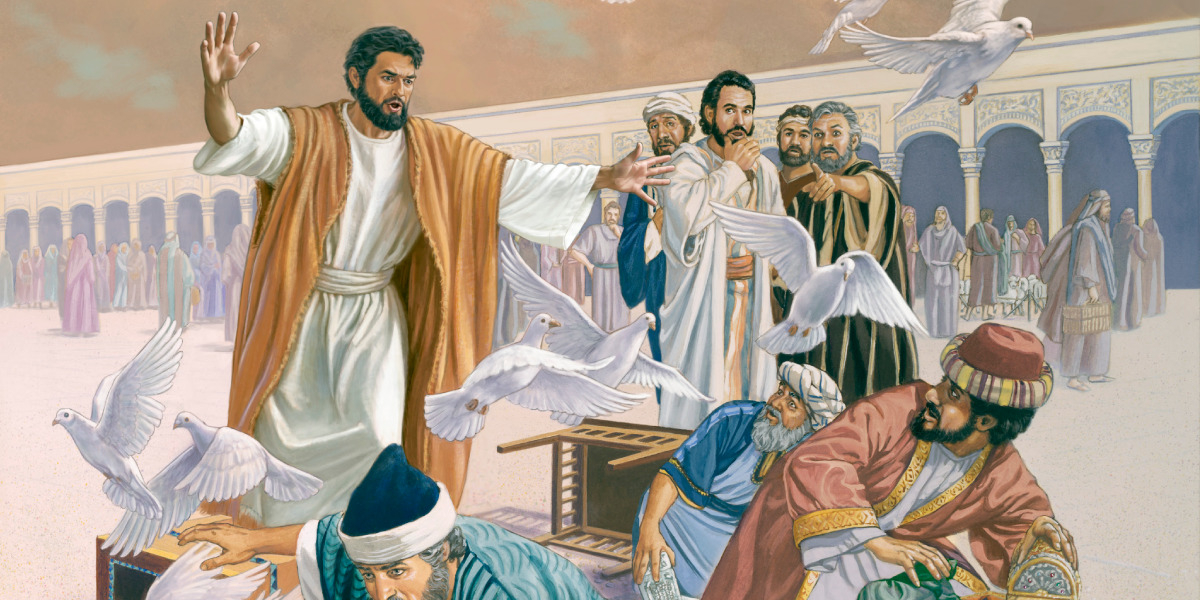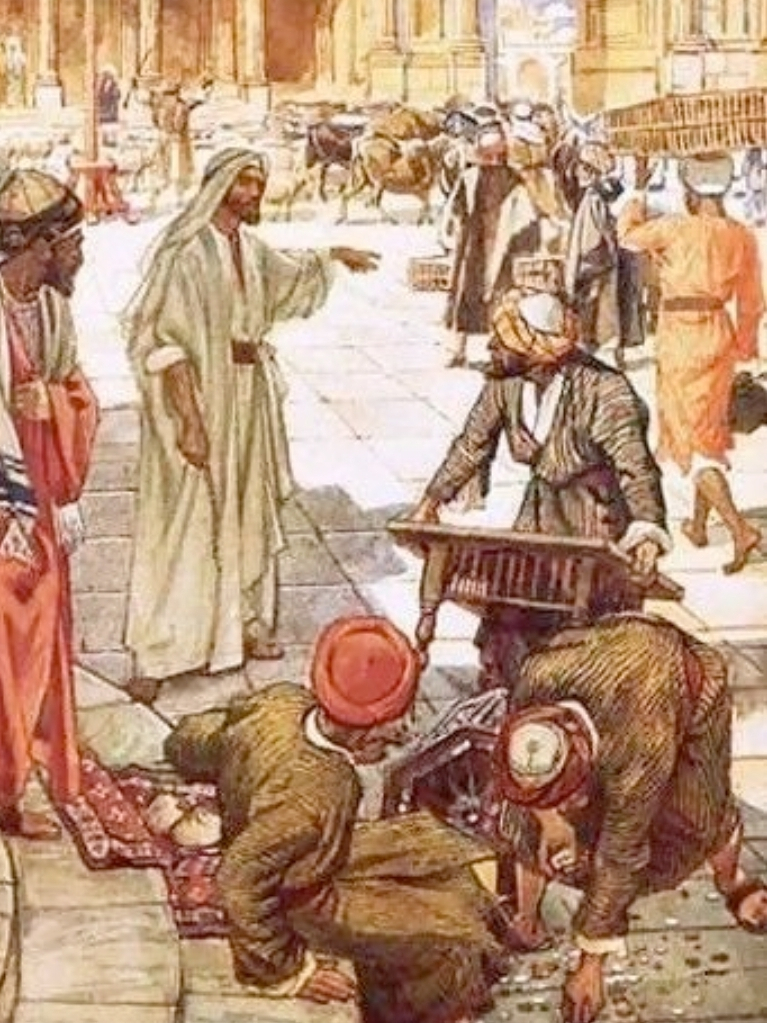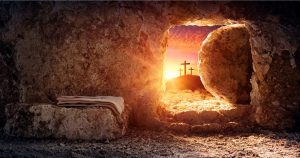
Mark 11:15 AV
Then they came to Jerusalem.
And He entered the temple
and began to drive out those
who were buying and selling in the temple,
and overturned the tables of the money changers
and the seats of those who were selling doves
Other translations
And they came to Jerusalem. And He went into the temple [area, the porches and courts] and began to drive out those who sold and bought in the temple area, and He overturned the [four-footed] tables of the money changers and the seats of those who dealt in doves; [AMP] And they came to Jerusalem. And he entered the temple and began to drive out those who sold and those who bought in the temple, and he overturned the tables of the money-changers and the seats of those who sold pigeons. [ESV] They arrived at Jerusalem. Immediately on entering the Temple Jesus started throwing out everyone who had set up shop there, buying and selling. He kicked over the tables of the bankers and the stalls of the pigeon merchants. [MSB] And they come to Jerusalem: and Jesus went into the temple, and began to cast out them that sold and bought in the temple, and overthrew the tables of the moneychangers, and the seats of them that sold doves; [KJV] On reaching Jerusalem, Jesus entered the temple area and began driving out those who were buying and selling there. He overturned the tables of the money changers and the benches of those selling doves, [NIV] When they arrived back in Jerusalem, Jesus entered the Temple and began to drive out the merchants and their customers. He knocked over the tables of the money changers and the stalls of those selling doves, [NLT] So they came to Jerusalem. Then Jesus went into the temple and began to drive out those who bought and sold in the temple, and overturned the tables of the money changers and the seats of those who sold doves. [NKJV]
Study
And they came to Jerusalem
The Ethiopic version reads, “he came”; that is, the Christ; but He was not alone, for His disciples were with Him.
Beza says, that, he had met with one exemplar that added “again”, and so did one of Stephens’s copies. This is not incorrect, for they indeed had been there the day before.
And He entered the temple
The Syriac and Persic versions add, “of God”.
Literally He went into the court of the Gentiles, as he had done the previous day.
Jesus went into the temple of God at Jerusalem, which was built by His order, and dedicated to His worship, and where before the Shechaniah, or the divine presence had been.
Christ did not go to the tower of David, the strong hold of Zion, the palace of his father David; for He entered not as a temporal king; but he went to the house of His heavenly Father, as the Lord and proprietor of it, to preach in it, and purge it.
Whereby the glory of the latter house became greater than that of the former; and so several prophecies had their accomplishment, particularly (Haggai 2:7,9; Malachi 3:1) though this was not the first time that the Christ’s was in the temple.
Yet this His entrance (the day before) was the most public and magnificent of any.
After, He had sent back the ass to their proper owners, as is very probable, He went by the eastern gate, called the king’s gate, (1 Chronicles 9:18) into the temple.
Temple
The large Court of the Gentiles was the setting for the events that followed.
Began to drive out those who were buying and selling
This happened, according to Matthew, on the same day that he made his public entry into Jerusalem, on the ass, when people enjoyed, and shouted “save us” (Hosanna) to Him.
Wherefore it is highly probable, that upon Christ’s leaving the city, they returned again, and were the next morning again sitting there, and doing business in the temple as usual; and that they were again driven out by the Christ, who, upon His return, found them there again.
This driving out of those who were buying and selling did not happen in the holy of holies, nor in the holy place, nor in the court of the priests, nor in the court of the Israelites, but in the court of the Gentiles, and in the mountain of the house, in which were shops, where various things were sold, relating to sacrifices.
buying and selling
Animals were needed by the Jews for their sacrificial temple offerings, and it was more convenient for the worshipers to buy them there, rather than bring the animals from a distance and risk that they would not pass the High-Priest’s inspection.
They “that bought and sold in the temple”, were those that bought and sold lambs for the passover, which was now at hand; and the sheep and oxen for the feast the day following.
The sellers either belonged to the High-Priestly hierarchy or paid a large fee to the temple authorities for the privilege of selling.
Whichever was the case, the High-Priest’s family benefited monetarily.
What these persons bought and sold, whom Christ cast out, is not said, but may be collected from (John 2:14) where besides “doves”, of which hereafter, mention is made, of “sheep” and “oxen”; which were brought to be sold, on account of the passover, for it was then near their time of passover as now; for besides the lambs, which were here also sold and bought for the passover supper, sheep and oxen were here also killed and sold for the ‘Chagiga’, or feast, which was the following day; here likewise the drink offerings were bought and sold.
Money changers
They were in the court to exchange Greek and Roman coins for Jewish or Tyrian
coins which pilgrims (every Jewish male 20 and older) had to use for the annual half-shekel payment for the religious services of the temple.
A fee as high as 10 or 12 percent was assessed for this exchange service.
Those who were selling doves
These birds were often used for sacrifice as doves were the normal offering of the poor (Leviticus 5:7), the doves mentioned, were required for the offerings of the poor mothers after birth, at the time of their purification, and on account of running issues: which cases were very frequent, and sometimes raised the price of doves very high, as well as for other purposes. There was a great demand for these creatures.

He Began to drive out those who were buying and selling
Upon arrival in Jerusalem, Jesus enters the temple just like the previous day (Mark 11:11); now, however, to put things in order.
Trade (exchange of foreign currency, sale of sacrificial animals) near the temple was, of course, inevitable.
▪︎ The prescribed temple tax was to be paid in the Jewish currency (shekel), so those who were going to the temple, and came from other parts of the Roman Empire (cf. Acts 2:9-11, 8:27) had to exchange their own coins.
▪︎ The sale of pigeons was primarily intended for those who were too poor to make any other sacrifice (cf. Leviticus 5:7, 12:8; Luke 2:24).
Jesus, however, opposes the place where this trade is conducted, namely IN the temple (in the sanctuary). This violates the sanctity of the place and degenerates what was supposed to be a house of prayer in a market square and even a “den of robbers” (Mark 11:17).
For a hefty fee, the chief priests granted traders permits to sell sacrificial animals in the Temple itself.
He drove the sellers and traders out of the temple like a herd of cattle and made further continuation of their trade impossible by overturning their tables.
With this prophetic act, Jesus anticipates the coming destruction of the temple (Mark 13:2) and at the same time fulfills certain Messianic prophecies according to which in the end of days the temple would be cleansed and restored to its glory (Zechariah 14:21; Ezekiel 40-47).
Twitter: @SchoemakerHarry
Website 1: https://devotionals.harryschoemaker.nl
Website 2: http://bijbelplaatjes.nl





Hallelujah